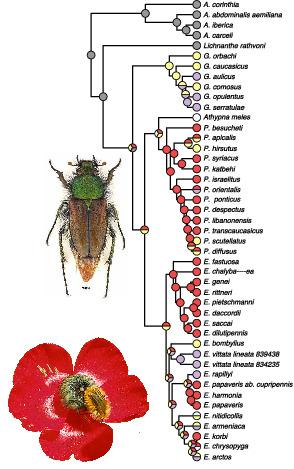当前位置:
X-MOL 学术
›
Syst. Entomol.
›
论文详情
Our official English website, www.x-mol.net, welcomes your
feedback! (Note: you will need to create a separate account there.)
A molecular phylogeny of Glaphyridae (Coleoptera: Scarabaeoidea): evolution of pollination and association with ‘Poppy guild’ flowers
Systematic Entomology ( IF 4.7 ) Pub Date : 2020-03-09 , DOI: 10.1111/syen.12429 Guido Sabatinelli 1 , Jonas Eberle 2, 3 , Silvia Fabrizi 2 , Dirk Ahrens 2
Systematic Entomology ( IF 4.7 ) Pub Date : 2020-03-09 , DOI: 10.1111/syen.12429 Guido Sabatinelli 1 , Jonas Eberle 2, 3 , Silvia Fabrizi 2 , Dirk Ahrens 2
Affiliation

|
Among Scarabaeoidea, pollen feeding occurs in two major lineages, pleurostict Scarabaeidae and Glaphyridae. Here we infer for the first time the phylogeny of the scarabaeoid lineage Glaphyridae (Coleoptera) based on molecular data using partial gene sequences for 28S rRNA, cytochrome oxidase I (cox1) and 16S rRNA (rrnL) for 41 species. Based on the resulting tree topology, we inferred the timing of the origin of pollination and of their coevolution with different flower host taxa, with particular focus on the prominent red‐coloured ‘poppy guild’ flowers. All genera of Glaphyridae that were sampled with multiple species were recovered as monophyletic. According to this analysis, the origin of Glaphyridae was around 140 Ma, while crown group divergence was dated to have occurred c. 112 Ma. Pollen feeding originated in Glaphyridae only once and much later than in other important pollinator groups, between 97 and 67 Ma. According to the reconstruction of ancestral feeding traits, Asteraceae (Cicharioidae) were the first hosts of Glaphyridae. Presumably, a further adaptive radiation was triggered by feeding on and pollination of red flowers (poppy guild) which arose at a later stage. It occurred for the first time between 30 and 40 Ma, whereby the clades that use red Ranunculaceae (Pygopleurus spp.) are older than clades using exclusively red Papaveraceae (Eulasia spp.) (25–30 Ma). The rather young age of red Ranunculaceae would imply that Pygopleurus species only subsequently used red Ranunculus species as flower hosts, and that a broad parallel host shift probably from red Papaver spp. to red Ranunculus asiaticus has occurred rather recently.
中文翻译:

Glaphyridae(鞘翅目:Scarabaeoidea)的分子系统发育:授粉的进化和与“罂粟公会”花的关联
在金龟子科中,花粉取食发生在两个主要谱系中,胸膜金龟科和蓝蝶科。在这里,我们首次使用 41 个物种的 28S rRNA、细胞色素氧化酶 I (cox1) 和 16S rRNA (rrnL) 的部分基因序列,根据分子数据推断金龟子谱系 Glaphyridae(鞘翅目)的系统发育。基于由此产生的树形拓扑结构,我们推断了授粉起源的时间以及它们与不同花宿主分类群的共同进化,特别关注突出的红色“罂粟公会”花。与多个物种一起采样的 Glaphyridae 的所有属都被回收为单系。根据这一分析,Glaphyridae 的起源在 140 Ma 左右,而冠群分化发生在 c. 112 马。花粉取食仅起源于 Glaphyridae 一次,并且比其他重要传粉媒介群体晚得多,在 97 到 67 Ma 之间。根据祖先取食性状的重建,菊科(Cicharioidae)是菊科的第一宿主。据推测,进一步的适应性辐射是由后期出现的红色花朵(罂粟行会)的摄食和授粉引发的。它第一次发生在 30 到 40 Ma 之间,其中使用红色毛茛科 (Pygopleurus spp.) 的进化枝比只使用红色罂粟科 (Eulasia spp.) 的进化枝更古老 (25-30 Ma)。红色毛茛科的相当年轻的年龄意味着 Pygopleurus 物种随后仅使用红色毛茛属物种作为花宿主,并且广泛的平行宿主可能从红色罂粟属转移。
更新日期:2020-03-09
中文翻译:

Glaphyridae(鞘翅目:Scarabaeoidea)的分子系统发育:授粉的进化和与“罂粟公会”花的关联
在金龟子科中,花粉取食发生在两个主要谱系中,胸膜金龟科和蓝蝶科。在这里,我们首次使用 41 个物种的 28S rRNA、细胞色素氧化酶 I (cox1) 和 16S rRNA (rrnL) 的部分基因序列,根据分子数据推断金龟子谱系 Glaphyridae(鞘翅目)的系统发育。基于由此产生的树形拓扑结构,我们推断了授粉起源的时间以及它们与不同花宿主分类群的共同进化,特别关注突出的红色“罂粟公会”花。与多个物种一起采样的 Glaphyridae 的所有属都被回收为单系。根据这一分析,Glaphyridae 的起源在 140 Ma 左右,而冠群分化发生在 c. 112 马。花粉取食仅起源于 Glaphyridae 一次,并且比其他重要传粉媒介群体晚得多,在 97 到 67 Ma 之间。根据祖先取食性状的重建,菊科(Cicharioidae)是菊科的第一宿主。据推测,进一步的适应性辐射是由后期出现的红色花朵(罂粟行会)的摄食和授粉引发的。它第一次发生在 30 到 40 Ma 之间,其中使用红色毛茛科 (Pygopleurus spp.) 的进化枝比只使用红色罂粟科 (Eulasia spp.) 的进化枝更古老 (25-30 Ma)。红色毛茛科的相当年轻的年龄意味着 Pygopleurus 物种随后仅使用红色毛茛属物种作为花宿主,并且广泛的平行宿主可能从红色罂粟属转移。









































 京公网安备 11010802027423号
京公网安备 11010802027423号